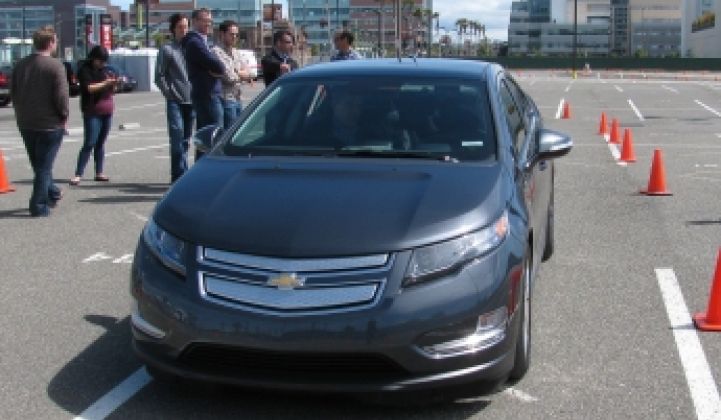General Motors snuggled closer to Google on Tuesday by announcing it will use Google Maps to add location-based features to its Chevy Volt mobile app.
The carmaker said that with the release of version 2.0 of the app running on Google's Android software, the smart-phone application will pinpoint the location of cars, and even transmit voice-guided directions.
GM unveiled the mobile app in January at the Consumer Electronics Show. In its present form, it allows owners of the upcoming Volt electric hybrid to check battery charge levels, unlock doors and start engines.
The joint development with Google is clearly a feather in the cap of GM's OnStar, which is developing the app. Mobile apps are among the hottest trends in technology, and location-based services make a great deal of sense in cars.
But the real news on Tuesday was the Volt itself. GM has been guarding details of the car's feel and handling, and it cast aside the curtain to offer test-drives to a handful of San Francisco journalists. The verdict: largely favorable. (Photos and videos coming soon.)
The Volt is GM's first foray into the emerging electric car market, and instead of a tiny lightweight two-seater, it is a roomy-enough mid-sized vehicle in keeping with the majority of cars on the road today.
It boasts respectable economy, with a 375-pound lithium-ion battery from LG Chemicals that is capable of a 40-mile range. The 16-kilowatt-hour battery has 220 cells and a GM-designed heating and cooling system to preserve performance in cold and hot weather conditions. Both heat and cold weather can rob a battery of its charge.
When the battery is drained, a 1.4-liter, 4-cylinder gasoline powered generator kicks in to provide juice to the electric motor. Fisker Automotive has adopted a similar series hybrid design for the upcoming Karma. The Nissan Leaf, of course, runs on pure electricity, but has to have a larger, 24-kilowatt-hour battery.
The car has a comfortable feel on the road. Its shocks are soft enough to absorb the ride and its steering is tight. Like many cars with high-efficiency electric motors, the vehicle has pep and is responsive.
GM is fond of saying, "it feels like a car," and it does, with the exception that it is quiet. The pleasure of leaving a parking spot with little to no noise is hard not to appreciate.
GM created uncertainty about the Volt by warning that the production model, expected before the end of the year, will differ from the prototypes it is showing off. But Tony Posawatz, vehicle line director, put some of the questions to rest.
"The (exterior) look is pretty much representative of what you'll see in production," he said. Some small interior changes could take place.
But Posawatz did not solve the biggest mystery: the price. GM has suggested the car could cost about $30,000 after a $7,500 federal tax credit. But late summer is when the sticker will be finalized, he said. "We're still working through some details."



